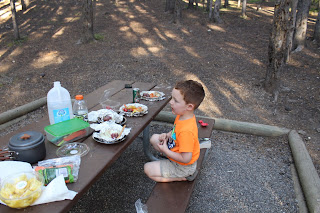Last week we got the opportunity to see how handmade Turkish rugs are made. I never knew how labor intensive making a quality rug can be.
While visiting the Goreme Open Air Museum, our tour guide told us about a place near by that you can see locals making rugs, from the spinning to the final rug. It's a cooperative, Matis Carpet is the name (I think).
We arrived at the end of the day, but there were still 3 ladies there, as well as 1 guy who spoke English. I hate not being able to speak Turkish! I can understand a little. In specific settings I understand quite a bit, like when my friend was telling the waiter to put her order on a separate bill at lunch last Sunday. I was able to argue enough in Turkish to tell him 1 bill, but she won in the end by threatening to never eat out with us again (and she's so stubborn like me, that she would stick to it and not eat out with us E.V.E.R. again).
I digress, where was I? Oh, yeah, not being able to communicate in Turkish. I'm studying it. S.L.O.W.L.Y.
They only use natural dyes. They crush various plants, boil them and then soak the yarn in it to create such beautiful colors.
There was a guy who explained to us how they collect the silk from the silk worm cocoons and spin it. First, the cocoons are soaked in hot water to loosen the fibers. Then, they take a straw brush and beat the water with it several times in order the catch the fibers. Once there are about 25 strands on the straw brush, they are attached to the spindle and spun around and around, creating silk thread. There is about 1 mile of silk in 1 cocoon. After the silk is spun into thread, it needs to be boiled because it is coated in a layer of glue type stuff. Once the thread has been boiled, it is silky soft and oh so luxurious. After that they dye the thread.

After learning about how silk is produced, we got to learn how rugs are actually created. The ladies have a pattern hanging on the loom (the blue and orange thing above their heads in the picture) which shows them the design. It said that just by looking at it, they tell where they left off the day before. They also don't have to count squares, they can tell what goes next just by looking. The rug they were working on will have over 6 million knots. For 1 person working alone on it, it would take about 2 years to complete the rug. For both of them working together, it will take about 1 year to complete the rug.
The girls even got to knot a few knots on a rug.
There are different ways to knot, like single knot, or double knot. The double knot is stronger. As years go by, the knots will actually get tighter from use.
The design that you see, it composed of individual knots! 1 square centimeter can have up to 100 individual knots! That's roughly 100 knots on your thumb nail!

In 1 day, they will complete about 1 row of knots. Silk yarn is finer than the wool yarn. Here they are working on a silk on silk rug. It was so so soft! And the colors was just beautiful! I'm a sucker for blues for sure.


The ladies loved showing the girls how they do their work. And even though Little Man was running around like a crazy man, everyone just found him adorable. In Turkish culture, kids can basically do no harm...even when there are expensive things around.
Take for example the picture below. Little Man and Princess are wrestling on thousands of dollars worth of handmade Turkish rugs! The blue rug on the right costs $13,000 USD ALONE! Daniel and I kept telling the kids to stop walking on the rugs, to stop wrestling and rolling around on them, to just look at them. The guy showing us the rugs kept telling us, "It's no problem. They are kids, let them be. They're fine." I kept thinking, "Yeah, they're fine until they ruin something." I mean, if you've met my son, you know that he is a wrecking ball in a china store. He is a tornado and hurts himself, or something, on a near daily basis. But we let them roll around, ate the man's insistence, while we talked about Turkish rugs and life in general.

We learned that how to tell the quality of a run, you must flip the rug over to examine the back. You can see the amount of knots per square cm more easily. Ones with fewer knots are more pixilated in design. The more knots a rug has, the clearer the design is. For the most high quality rugs, the design on the back is almost just as clear as on the front! You would hardly be able to see where the knots are.
Before we visited this place, I thought Turkish rugs (well, most all rugs) were so expensive; so over priced. After this learning experience, I see the time and effort that goes into creating such works of art. Imagine sitting at a loom every day, for 1 year, tying knots and making such a beautiful rug, just to sell it for like $300. I'd be appalled too! Sadly, that's what I thought I'd be willing to spend on a rug before seeing the work that goes into it. I mean really, imagine working on something for 1 year, and only receiving $300 for it. Your yearly wage of $300, absurd. So no wonder handmade Turkish rugs are worth thousands of dollars.
































































